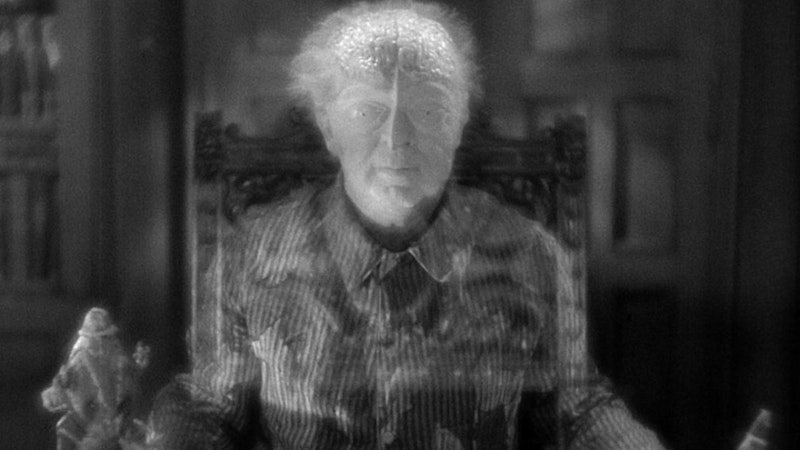Fritz Lang’s The Testament of Dr. Mabuse (1933) is a fascinating, fitting, and truthful conclusion of the Weimar Republic. At that point, National Socialists have risen in power, and we know the darkness that will cover the world. What Lang tried to do with Mabuse was issue a warning of the impending doom. In 1943, Lang tried to explain his intentions: “This film was made as an allegory to show Hitler’s processes of terrorism. Slogans and doctrines of the Third Reich have been put into the mouths of criminals in the film. Thus I hoped to expose the masked Nazi theory of the necessity to deliberately destroy everything which is precious to a people…Then, when everything collapsed and they were thrown into utter despair, they would try to find help in ‘new order’.”
Much like M (1931), Lang explores the hierarchy of German society. There’s a sense of disorder, permanent chaos, and a societal inability to achieve order. Different spheres of society are permanently separated, and they never work toward the same goal.
In Mabuse, we witness Dr. Baum, a psychiatrist in an insane asylum, treating one of his patients, the infamous Dr. Mabuse. Baum’s a respected member of the society. He’s a doctor, an asylum director, and a professor of psychiatry, shaping new minds in a fairly new field of study. As his life is moving on a usual and uneventful trajectory, Mabuse spends his days in a cell, feverishly writing. These scribbles turn out to be plans on how to successfully disrupt order: burning down the chemical factories, destroying the rail system, unleashing epidemics, and an attack on the economy and work—all to start from zero and rebuild a society in his own mad image. Once the people are beaten down, then the real change and obedience to authority can begin.
At first, Baum looks at all of Mabuse’s mad scribbles clinically and professionally. But something begins to change in him. Much like Dr. Caligari, he falls under the spell of Mabuse. In fact, after Mabuse dies in the insane asylum, his ghostly presence takes over Baum, and Baum begins to execute Mabuse’s evil plan.
He takes over the underworld and creates different divisions that carry out his plans. Loyalty to this reign of terror is important, and Baum/Mabuse doesn’t take kindly when one of the crime “executives” begins to draw a line between petty crime and murder. Kent’s a man who’s trying to live a good life. He’s an engineer, who served time in prison but now honestly wants to work. As he says, he “doesn’t want charity or handout,” just work. But there’s no work. Unemployment is high, and so he turns to working for Baum/Mabuse.
None of the criminals have ever met Baum/Mabuse. They receive orders through a piece of paper, and in a room where he’s hidden behind a large curtain. It turns out that the shadow of Baum/Mabuse was a cut-out silhouette and the voice was a recording. This helps in capturing Baum/Mabuse and through Inspector Lohmann’s determination, Baum’s captured, except there’s no justice. Much like Mabuse, he’s just another patient in an insane asylum. Lohmann’s victory is superficial but the question that arises is whether Mabuse’s plan will be realized now that the directives have been sent into society? Will another madman pick up the pieces of an outlines regime of terror, and carry it out? Or is he a madman at all but rather an immoral and evil person? Is feigning madness just another way of getting out of moral responsibility?
While National Socialists loved and perverted the meaning of Lang’s Metropolis (1927), they hated Mabuse, and Goebbels promptly banned it. But even so, is this really an indication that Mabuse is clearly an anti-Nazi film? Lang had clear ideas on what the film was meant to signify, but as Siegfried Kracauer points out, “...it is hard to believe that average German audiences would have grasped the analogy between the gang of screen criminals and the Hitler gang. And had they even been aware of it, they would not have felt particularly encouraged to stand up against the Nazis, for Lang is so exclusively concerned with highlighting the magic spell of Mabuse and Baum that his film mirrors their demoniac irresistibility than the inner superiority of their opponents.”
Perhaps Lang made those comments of his intention in hindsight. Perhaps it wasn’t entirely clear to him whether there was an explicit connection between Mabuse and Hitler, yet if he’d made the connection any more clear, then the film would’ve been a piece of political “art.” Kracauer is not entirely fair to Lang, especially since he himself tries to fit his particular theories about the psychology of National Socialism into Weimar cinema.
For all its focus on German issues, Mabuse is a strangely “American” film. Inspector Lohmann is hardly German: he’s a cigar-smoking, joke-making, portly man, who isn’t concerned with strata of society but entirely with justice. There’s something “American” about his personality, and the relationships of criminals with each other and Mabuse has more in common with gangster films than Nazism. One can see the development of Lang’s style as he continues his career in the United States.
Lang’s intentions did succeed because after all these decades, Mabuse still resonates. It deals with the perennial question of evil and power. Evil men will never cease to exist, and we should be aware of any reign of terror, however small or insignificant.

